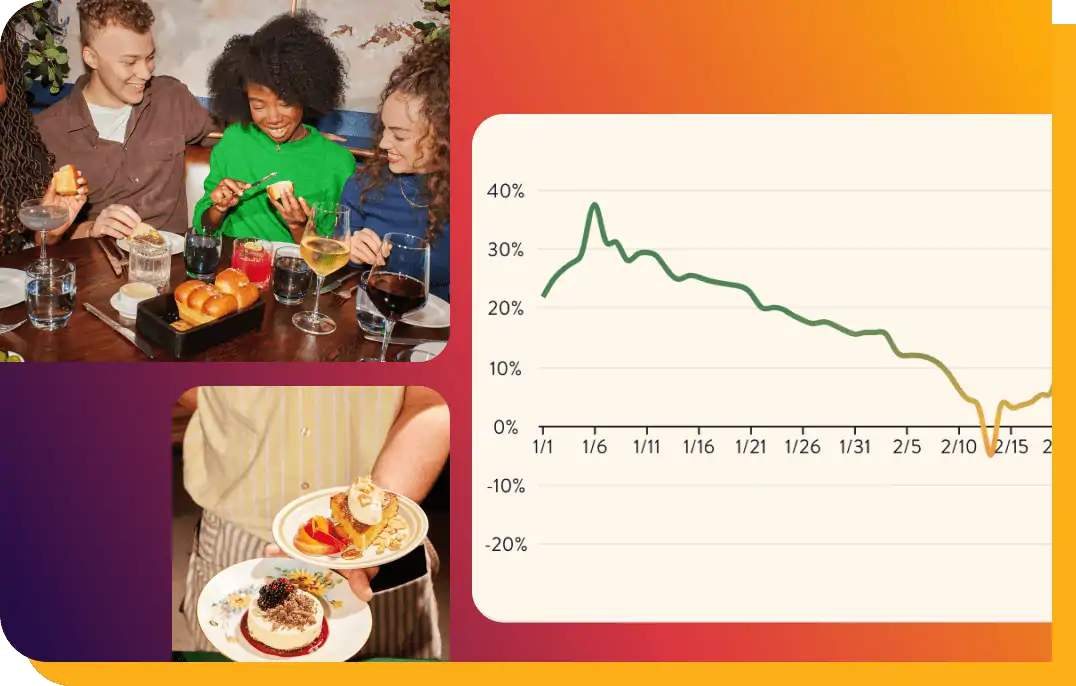Restaurant sustainability practices can start small. You don’t need a complete overhaul to make meaningful change, with simple adjustments often having an environmental impact while even saving money. From reducing food waste to choosing energy-efficient appliances, these ten sustainable dining practices will help you build a greener restaurant in 2025. Best of all, you can start implementing them now.
The importance of sustainability in the restaurant industry
Making your restaurant more sustainable matters. Rising energy costs and food waste can quickly eat into profits. Studies also show that 85% of diners consider a restaurant’s environmental practices when deciding where to eat. It turns out that going green drives business and builds customer loyalty.
But the bigger impact is on the planet. Restaurants generate between 22 and 33 billion pounds of food waste every year and consume five times more energy per square foot than other businesses. Every sustainable change made helps reduce the environmental toll.
How can a restaurant practice sustainability?
Restaurant sustainability practices start with clear, actionable steps. No matter how small, each change adds up to create an environmental impact. These ten steps offer straightforward ways to make your restaurant more eco-friendly.
Optimize waste management
Save money and shrink your environmental footprint by reducing food waste and managing trash more effectively.
1) Track your waste
Regular food waste audits can reveal what’s being thrown away, helping you adjust prep and ordering to match your needs. Smart inventory management helps identify waste patterns and opportunities to reduce costs. And the numbers show that investing in waste reduction pays off, with every $1 spent saving restaurants up to $7 in operating costs.
2) Donate and repurpose
Turning usable leftovers into new menu items can help minimize waste. Yesterday’s bread might make excellent croutons, while vegetable trimmings create flavorful stocks. With over 80% of unused restaurant food ending up in landfills and only 1% donated, partnering with food banks is another way to help your business reduce waste while supporting your community.
3) Control portions
Roughly one-third of served food goes uneaten, so think about portion sizes. Up to 10% of purchased food never even reaches the diner. Consider offering flexible portions, half-size options, and takeaway boxes to help guests enjoy their meals while reducing waste.
Source sustainable ingredients
Where you source your food has an impact on sustainability. Choosing locally produced, seasonal, and eco-friendly ingredients can reduce emissions and improve food quality. It also aligns with diner values, as guests increasingly favor restaurants that are conscious about their supply chain.
4) Buy local
Partnering with local farmers and suppliers cuts down on miles and carbon emissions while supporting your community. Beyond the environmental impact, local sourcing means fresher ingredients arriving at your door. With 38% of diners more likely to choose restaurants offering local foods, it’s a meaningful way to be sustainable and attract diners.
5) Choose sustainable products
From organic produce to humanely raised meats and certified seafood, sustainable ingredients limit harmful practices in the food supply chain. These choices align with growing consumer values around environmental responsibility. Restaurants highlighting sustainable ingredients see the impact, with 30% of diners actively seeking eco-conscious dining options.
Enhance energy and water efficiency
Restaurants consume plenty of energy and water, driving up utility bills and increasing the carbon footprint. In fact, restaurants use roughly 3× more energy per square foot than other commercial businesses, and a typical restaurant uses about 300,000 gallons of water annually. Improving efficiency means you can cut costs and operate more sustainably.
6) Upgrade to energy-efficient kitchen equipment
Upgrading to ENERGY STAR-rated kitchen equipment can reduce power consumption. Energy-efficient refrigerators, ovens, fryers, and dishwashers might cost more upfront but often pay for themselves through lower utility bills. Some businesses, like Starbucks, have cut energy usage by 25% just by switching to efficient appliances.
7) Minimize idle energy waste
Training staff to switch off idle equipment and unused lights can lead to energy savings. A single commercial fryer turned off for four hours each day saves $350 per year in energy costs. Simple operational changes like using programmable thermostats during off-peak hours can lower utility bills without requiring any investment.
Promote sustainable dining
Building a culture of sustainability might start at your restaurant, but it gains life through your guests. Engage with diners and show them how you’re being a more sustainable restaurant.
8) Feature sustainable menu choices
Expand your menu with eco-friendly options, such as plant-based dishes (they use less water and create fewer emissions than meat-heavy meals). Doing so will help with the environmental impact. Consider adding vegetarian specials, clearly mark sustainable choices, and feature MSC-certified seafood. Well-crafted descriptions and recommendations from servers can help guide guests toward earth-friendly options.
9) Engage guests in your sustainability efforts
Invite guests to join your sustainability journey. Include simple menu notes about water conservation or explain your straw policy to show transparency about environmental efforts. Approximately 68% of diners want restaurants to avoid waste, and clear communication about your initiatives can help build guest loyalty and shared purpose.
10) Showcase and market your green initiatives
Share your sustainability journey through social media and in-restaurant messaging, from milestones in waste reduction to responsible sourcing achievements. Transparency about environmental initiatives can strengthen guest relationships and attract new customers. Many diners are willing to pay more at restaurants that demonstrate clear, sustainable practices.
Which restaurants are leading the sustainable charge?
From finding new uses for food scraps to transforming ocean waste into dining room furniture, restaurants are already proving that sustainability comes in many forms. Their innovative approaches show how small changes and bold initiatives can create meaningful environmental impact.
Take New York’s Point Seven. It has built sustainability into its foundation, using dining tables and countertops made from recycled ocean plastic. At Hav & Mar, the bar team turns potential waste into creative cocktails. Its signature martini features leftover pickling liquid, while celery scraps find new life in specialty spritzes.
In DC, SHIA is tackling sustainability through practical changes. Its all-electric kitchen and single-stream recycling program show how small steps add up. The team tracks waste to identify opportunities for better sourcing and disposal methods.
These innovators demonstrate that sustainability can take many forms, be it smart design choices, creative menu planning, or tracking resources. Their successes offer a roadmap for reducing environmental impact.
Making your restaurant more eco-friendly
Starting your sustainability journey doesn’t require radical changes. Begin with what makes sense for your restaurant, whether that’s reducing food waste, sourcing locally, or improving energy efficiency. Small steps today can lead to meaningful environmental impact tomorrow while attracting eco-conscious diners and reducing costs.




